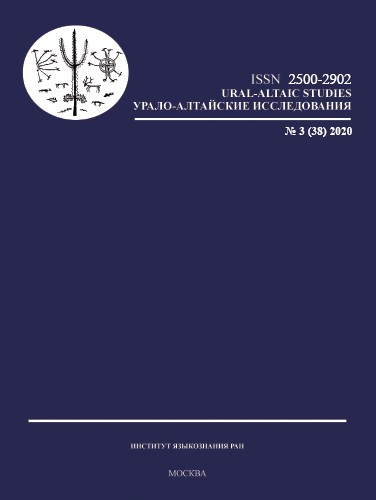К особенностям перевода «Закона Божия» (1912 г.) на удмуртский язык: глагольная морфология
The peculiarities of the translation of “God’s lawˮ (1912) into Udmurt: verbal morphology
Author(s): Maria P. BezenovaSubject(s): Phonetics / Phonology, Morphology, Finno-Ugrian studies, Pre-WW I & WW I (1900 -1919), Translation Studies
Published by: Институт языкознания Российской академии наук
Keywords: the Udmurt language; dialectology; written sources; verbal morphology;
Summary/Abstract: This article examines the verbal morphologic characteristics of the translation of “God’s Law” into the Udmurt language. The relevance of the study lies in the fact that written monuments are one of the main sources for studying the history of the language, but most of Udmurt written monuments have not yet been examined. The description of morphological characteristics in the article is based on a previous analysis of the graphic and phonetic systems of the translation of “God’s Law” into Udmurt. The main research method is comparing the linguistic material of the monument with the data of the modern literary Udmurt language and its dialects. The paper discusses in detail the categories of mood, tense and voice, which are characteristic of the modern Udmurt language, as well as non-conjugated forms of the verb, which include the infinitive, participle, and gerund. As a result of the analysis, in the monument it was discovered that a number of features characterized by the use of markers with the ы vowel in accordance with the и in the literary language and the South Udmurt dialects in the forms of the reflexive voice, the present tense of the 1st and 2nd persons, the past non-evidential tense of the 3rd person plural, present participles, formed from the verbs of the 1st conjugation. All the ы vowel variants turned out to be archaic in origin, and the и vowel variations are explained by the change of the original ы into и before the palatal consonant. In the translation of “God’s Law” only one marker was identified as innovative, this is an indicator of the gerund -чёзь (-тчозя-). Thus, the analysis showed that the verbal morphological system of the monument is archaic.
Journal: Урало-алтайские исследования
- Issue Year: 2020
- Issue No: 03 (38)
- Page Range: 19-32
- Page Count: 14
- Language: Russian

